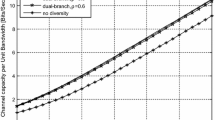Abstract
This paper presents a comparative analysis of dual-branch maximal-ratio combining (MRC) and equal-gain combining (EGC) receivers with coherent modulations over correlated Weibull fading channels. The numerical and simulations results show the influence of imperfect cophasing, branch unbalancing and correlation on the error performance. It is interestingly shown that EGC has lower irreducible error floor than MRC in the presence of incoherent combining, while the higher value of the correlation coefficient results to lower irreducible error floor. Furthermore, the unbalance parameter has practically no influence on the irreducible error floor.
Similar content being viewed by others
References
Babich F., Lombardi G. (2000) Statistical analysis and characterization of the indoor propagation channel. IEEE Transactions on Communications 48(3): 455–464
Tzeremes G., Christodoulou C. G. (2002) Use of Weibull distribution for describing outdoor multipath fading. Antennas and Propagation Society International Symposium 1: 232–235
Cheng J., Tellambura C., Beaulieu N. C. (2004) Performance of digital linear modulations on Weibull slow-fading channels. IEEE Transactions on Communications 52(8): 1265–1268
Simon M. K., Alouini M. S. (2005) Digital communication over fading channels, 2nd ed. Wiley, New York
Karagiannidis G. K., Zogas D. A., Sagias N. C., Kotsopoulos S. A., Tombras G. S. (2005) Equal-gain and maximal-ratio combining over Nonidentical Weibull fading channels. IEEE Transactions on Wireless Communications 4(3): 841–846
Dong X., Beaulieu N. C. (2002) Average level crossing rate and average fade duration of low-order maximal ratio diversity with unbalanced channels. IEEE Communications Letters 6(4): 135–137
Sagias N. C., Karagiannidis G. K., Mathiopoulos P. T., Tsiftsis T. A. (2006) On the performance analysis of equal-gain diversity receivers over generalized Gamma fading channels. IEEE Transactions on Wireless Communications 5(10): 2967–2974
Najib M. A., Prabhu V. K. (2000) Analysis of equal-gain diversity with partially coherent fading signals. IEEE Transactions on Vehicular Technology 49(3): 783–791
Sagias N. C., Karagiannidis G. K. (2005) Effects of carrier phase error on EGC receivers in correlated Nakagami-m fading. IEEE Communications Letters 9(7): 580–582
Sagias N. C., Karagiannidis G. K. (2005) Gaussian class multivariate Weibull distributions: theory and applications in fading channels. IEEE Transactions on Information Theory 51(10): 3608–3619
Gradsteyn I. S., Ryzhik I. M. (2000) Table of Integrals, Series, and Products, 6th ed. Academic, New York
Matolak D. W., Sen I., Xiong W. (2008) Generation of multivariate Weibull random variates. IET Communications 2(4): 523–527
Jeruchim M. C., Balaban P., Shanmugan K. S. (2000) Simulation of communication systems—modeling, methodology, and techniques. Kluwer, New York
Author information
Authors and Affiliations
Corresponding author
Rights and permissions
About this article
Cite this article
Nikolic, B.Z., Djordjevic, G.T. & Karagiannidis, G.K. On the Effect of Imperfect Cophasing in MRC and EGC Receivers Over Correlated Weibull Fading. Wireless Pers Commun 62, 31–39 (2012). https://doi.org/10.1007/s11277-010-0036-2
Published:
Issue Date:
DOI: https://doi.org/10.1007/s11277-010-0036-2




